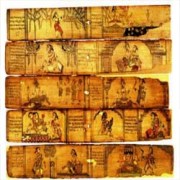Ancient India Economy in Vedic Age
The Aryans entered the northern part of India from Central Asia by 1500 BC. The Aryans re kindled the light of a new economy on the banks of the river Ganges. The Aryan society was characterized by a nomadic lifestyle and cattle rearing being the chief occupation. Cattle and cows were held in high esteem and frequently appear in Rigvedic hymns; goddesses were often compared to cows, and gods to bulls.
Aryans had learned to use iron by 1,000 BC and as the community settled down, Agriculturegained prominence. In the course of time Aryans went on to became farmers.They learned to farm rice cultivationby 600 BC. It’s because of farming activity a more ordered and settled society evolved.
Society was strictly organized on caste system and the economic structure stood of the division of labour of the caste. While the Aryans became the priests, rulers, warriors, peasants and merchants, the lower rank was left for the natives called as Shudra. The occupations were based on four major varnas, Brahmin, Kshatriya, Vaishya and Shudra.
The food of the Rigvedic Aryans consisted of parched grain and cakes, milk and milk products, and various fruits and vegetables.

Families were patrilinealConsumption of meat was also common among, at least among the upper classes. The Rigveda contains many references to animal sacrifice and meat offered to the gods.
The people in the Vedic period lived in straw and wooden huts. Some homes during the epics period were made of wood.They also introduced horse and chariot races.The social life cantered on Yagna meaning s a ritual of sacrifice.
Money was unknown, and bartering with cattle and other valuables was the favoured way of conducting trade and commerce.
With a more settled and ordered society trade and commerce started to flourish. Life in towns evolved again and writing was re-invented. By 600 BC a highly civilized society had emerged in India with its economy based on rural mode of production and its surplus being exported through trade and commercial activities.
With a more settled and ordered society trade and commerce started to flourish. Life in towns evolved again and writing was re-invented. By 600 BC a highly civilized society had emerged in India with its economy based on rural mode of production and its surplus being exported through trade and commercial activities.


0 Comments:
Post a Comment